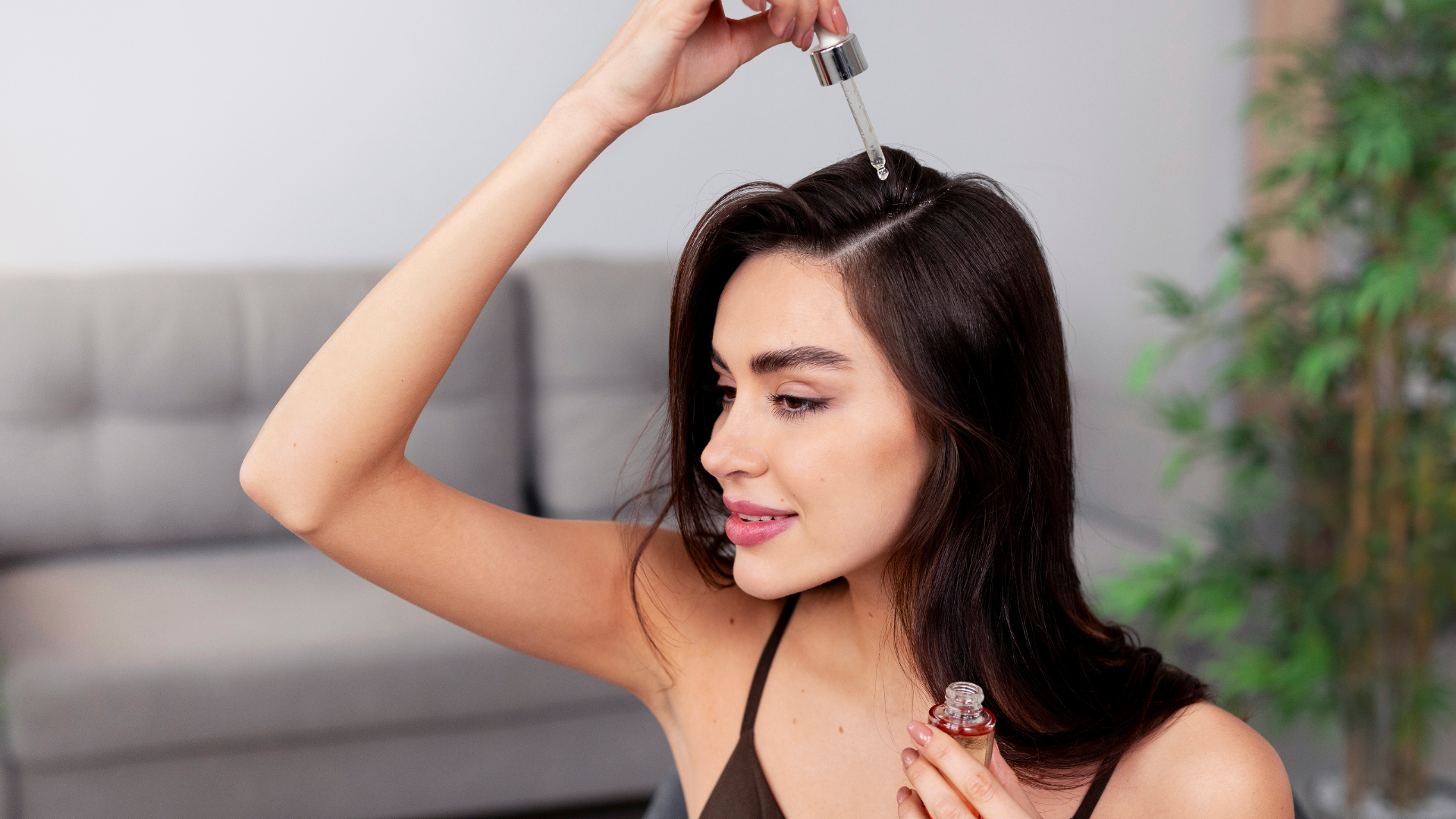Collagen, Recharged
While collagen supplements and powders provide essential building blocks for tissue repair, it’s the remodelling process—driven by active fibroblasts—that determines real structural benefit. This article explores how red light therapy stimulates collagen renewal at the scalp level, improving the extracellular matrix and creating a firmer foundation for hair growth.

Collagen has become one of the most talked-about ingredients in beauty and wellness—but for hair loss, and particularly in scarring alopecias, its role is complex.
There’s a common misconception that simply ingesting more collagen will support thicker hair growth and a healthier scalp. In truth, collagen supplements may provide the amino acid building blocks for repair, but they do not direct where or how collagen is deposited.
That work falls to fibroblasts—the cellular architects of the dermis, responsible for creating, breaking down, and reshaping collagen fibres as needed. Without active remodelling, added collagen is just potential, not progress.
In the scalp, type I and III collagen are the most prominent structural proteins. They provide rigidity to the dermal sheath, serve as a nutrient reservoir, and help support the transfer of growth factors and signalling molecules between cells. This extracellular matrix is not just a scaffold—it’s a dynamic environment that affects how well follicles can function, heal, and regenerate.
A particularly overlooked player is the arrector pili muscle—the tiny smooth muscle that gives you goosebumps. This structure is intimately connected to the hair follicle stem cell niche. In healthy skin, it helps direct stem cells into the lower follicle to initiate regrowth. But when fibrosis sets in, as it does in scarring alopecias, this muscle stiffens, contracts poorly, and eventually detaches from the follicle. Without movement, stem cell migration stalls—and regrowth halts.
Type I vs Type III Collagen: The Basics
-
Type I Collagen: The most abundant collagen in the body. It’s thick, densely packed, and provides tensile strength and structural rigidity.
-
Type III Collagen: More delicate and elastic. Found alongside type I in early wound healing and in more flexible, vascular tissues.
In a healthy scalp, both types coexist in a balanced ratio, forming a responsive matrix that supports blood flow, follicular anchoring, and cell signalling.
Why the Ratio Matters in the Scalp
1. Flexibility vs Rigidity
-
Higher Type III means the dermal matrix is more supple, elastic, and able to support cell migration and stem cell activation.
-
Higher Type I, especially when excessive, leads to a stiffer, more fibrotic environment, which limits tissue remodeling and compresses follicular units.
2. Healing vs Scarring
-
In early healing, type III dominates. Over time, it is replaced by type I to stabilise the tissue.
-
In chronic inflammation or scarring alopecias, this shift becomes exaggerated—resulting in too much type I, too little type III, and a dense, immobile matrix that impedes regrowth.
3. Blood Flow and Nutrient Delivery
-
Type III collagen is more vascular-friendly, allowing capillary networks to remain open and flexible.
-
An excess of type I collagen can restrict microcirculation, starving follicles of oxygen and nutrients.
Healthy Remodeling Requires Balance
An ideal type I : type III collagen ratio allows the scalp to:
-
Stay structurally sound, yet pliable
-
Support angiogenesis (new blood vessel formation)
-
Respond to injury or inflammation without tipping into fibrosis
-
Maintain the integrity of the follicle stem cell niche
In Hair Loss:
-
In scarring alopecias: You often see a pathological shift toward type I dominance, contributing to tissue rigidity and follicular dropout.
-
In diffuse thinning: A more balanced collagen profile can be preserved or restored—especially with interventions that promote type III collagen, like red light therapy, vitamin C, and copper peptides.
This is one reason scarring alopecias are considered permanent: the mechanical and biochemical links between tissue layers are broken. But the emerging consensus is more hopeful. If you can restore suppleness, improve vascularisation, and reactivate dermal remodelling, regrowth in previously scarred areas becomes possible.
The Problem Isn’t Too Little Collagen—It’s Too Much of the Wrong Kind
In scarring hair loss, collagen is deposited in dense, chaotic patterns that stiffen the dermis, restrict blood flow, and calcify around follicles. These hardened collagen bundles are often accompanied by calcium deposits, forming physical scar tissue that acts like concrete in the scalp. This severs the intricate signalling pathways and mechanical structures needed for follicular regeneration.
This is where collagen supplementation becomes misleading. Adding more collagen to an environment already burdened with fibrotic tissue doesn’t resolve the problem. The issue isn’t deficiency. It’s disorganisation.
In Thinning, It’s a Different Story
That said, in cases of non-scarring hair thinning—where the follicle structure remains intact but weakened, collagen peptides can help by supplying glycine, proline, and hydroxyproline—amino acids essential for fibroblast activity and healthy matrix production.
But collagen doesn’t work alone. Its integration into healthy tissue depends on how the body is signalling, and whether the surrounding environment encourages renewal or rigidity.
The Real Solution Is Not Collagen—It’s Remodelling
What stimulates productive, functional collagen renewal is mechanical stimulation (like scalp massage or sonic vibration), low-level red light therapy, and the right balance of micronutrients—particularly vitamin C, zinc, copper, and glycine. These inputs don’t just feed the system; they guide it. They reactivate fibroblasts and encourage organised, elastic collagen deposition, rather than the disordered buildup seen in fibrosis.
Red light therapy increases collagen production by triggering a series of cellular and biochemical responses within the skin and connective tissue. Here’s how it works, step by step:
1. Mitochondrial Activation
Red and near-infrared light (typically 630–850 nm) penetrates the skin and is absorbed by cytochrome c oxidase, an enzyme in the mitochondria. This boosts ATP (cellular energy) production.
Why it matters: Fibroblasts—the cells that produce collagen—become more metabolically active when ATP is abundant, enabling them to ramp up collagen synthesis.
2. Increased Fibroblast Proliferation
Studies show that red light stimulates fibroblast proliferation and migration, especially in dermal and connective tissues.
Why it matters: More active fibroblasts = more collagen, elastin, and ground substance being produced to support skin and scalp structure.
3. Modulation of Growth Factors
Red light therapy upregulates key signalling molecules such as:
-
TGF-β (Transforming Growth Factor Beta) – promotes collagen production and wound healing
-
VEGF (Vascular Endothelial Growth Factor) – improves microcirculation, which supports matrix turnover
-
FGF (Fibroblast Growth Factor) – directly stimulates fibroblast function
Why it matters: These growth factors not only boost collagen but also guide it to be deposited in organised, functional structures (vs. disordered scarring collagen).
4. Reduction in Matrix-Degrading Enzymes
Red light has been shown to downregulate MMPs (matrix metalloproteinases)—enzymes that break down collagen and elastin.
Why it matters: It helps maintain and protect newly formed collagen, supporting long-term skin and scalp integrity.
5. Anti-Inflammatory Effects
Chronic inflammation disrupts collagen production and encourages scar-like deposition. Red light reduces inflammatory cytokines (like IL-6 and TNF-alpha), creating a more balanced tissue environment.
Why it matters: A calm, oxygenated, low-inflammation environment is ideal for healthy collagen synthesis—not fibrosis.
Red light therapy doesn’t just increase collagen quantity—it improves its quality. By energising fibroblasts, enhancing growth factor signalling, and reducing matrix breakdown, it supports the development of flexible, functional collagen—critical for skin firmness, scalp pliability, and follicular support.
For scalps affected by thinning, tension, or scarring, the goal isn’t more collagen—it’s better collagen: mobilised, functional, and integrated into a healing environment.




